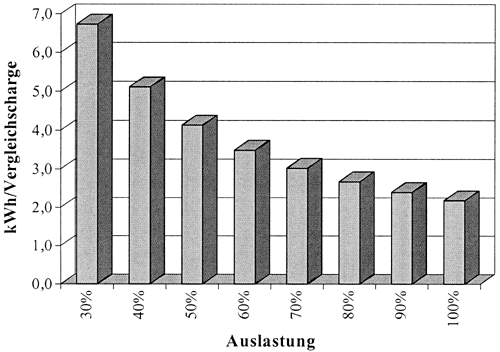
[ITUC Uni Jena] [Project Poster] [Article in JOT]
The figure below illustrates
the contributions of the subsystems to the total impact scores of the analysed
cleaning processes based on halogenated hydrocarbons. With regard to all cleaning
processes analysed it can be summarized:
• In most of the impact categories, the contribution of the cleaning process
itself is dominant.
• The big contribution is mainly caused by the current demand of the cleaning
machines.
• Reducing the cleaning machine’s demand for electric energy is one of the most
efficient optimisation potentials (i.e. using a gas or oil fired heating station
instead of electric heating).
• Capacity utilisation has a big influence to the environmental performance
of cleaning systems.
• An appropriate adaptation of the cleaning process to the cleaning task given
is very important.
Because of the relatively high energy demand the distillation capacity for the separtion of the dirt in solvent plants should be tuned to the amount of the removed dirt and the required cleaning quality. As these parameters change, the distillation power should be re-adjusted. To minimize costs, resources and emissions for the production of the cleaning agents and for the transports the distillation residue, which is handed over to the recycler should contain as little solvent as possible. Among the halogenated HC plants under study, which used filter to clean the emitted gases, those using active carbon filter-mats, generated considerably less amount of hazardous wastes. VOC emissions and therefore the POCP of non-halogenated HC plants can be reduced considerably by an optimized low-temperature condensation and by the utilization of active carbon for filtering the emissions from the vacuum pumps. An unsufficient low-temperature condensation may also pose, especially if warm air drying is also implemented, a safety risk.
With large lines of immersion baths, as are often needed with high cleaniliness requirements, considerable losses of heat along with the evaporation are determined. To run these plants as efficient as possible, one should have the throughput as high as possible, i.e. as amny charges as possible should be treated parallel in the baths. This could be achieved on the one handside by an adjustment of the cleaning programme and on the other side by the implementation of a second carrierer plus the related controls; it might also be necessary to adjust drying accordingly. A utilization of the heat emissions can make sense with high emission rate plants. For example with emissions having a temperature of 40° C the waste heat could be used to heat the workshop during the cold season by means of a static heat exchanger. One plant example under study demonstrated that one chamber flood plants with no open baths have considerably less heat losses. As this implies a reduced energy consumption, it should always be examined as to whether such a plant type is applicable. Unfortunately the throughput may pose a limiting factor in the utilization of this proposal.
All measures leading to reduction in energy consumption have a clear positive effect on environmental impatcs Maßnahmen, As energy prices continue to rise, this will also achieve cost savings.
The state of optimization and of the plant management have a strong impact on the ecologic efficiency. While deciding on new investments it is recommended to completely adjust the plant to the specific cleaning problem. Thereby one should not only consider the required cleaning capacity but also the plant dimensions. To keep a largy capacity buffer may result in an economic and ecologic inefficient production. Idling time should be avoided always.

Specific power concumption of a cleaning plant related to the utilization.
Many thanks to the team of "Bauteilreinigung" for allowing us to publish this (and other) pages.